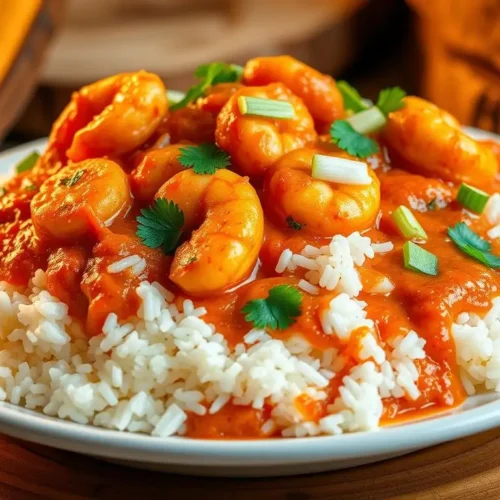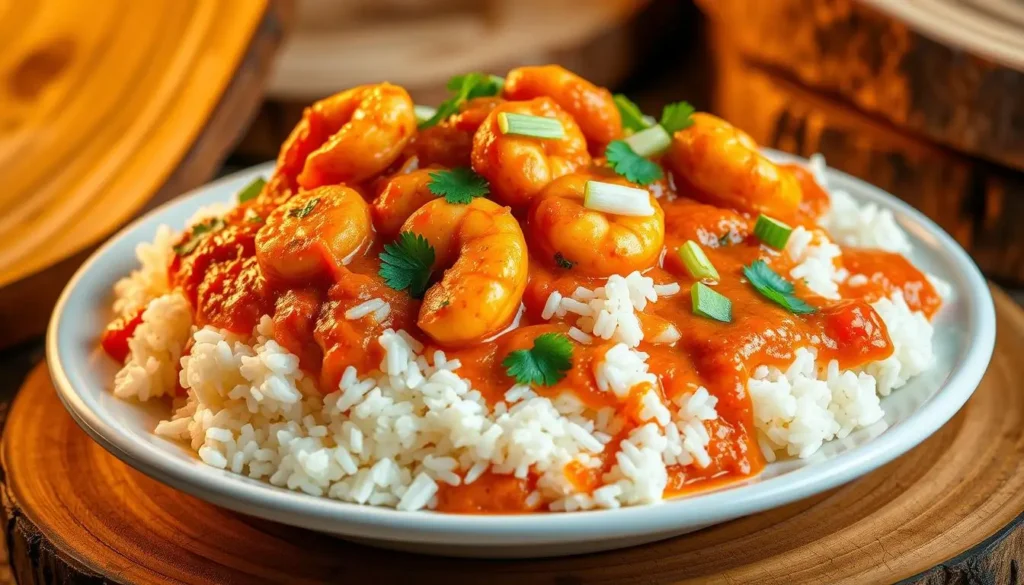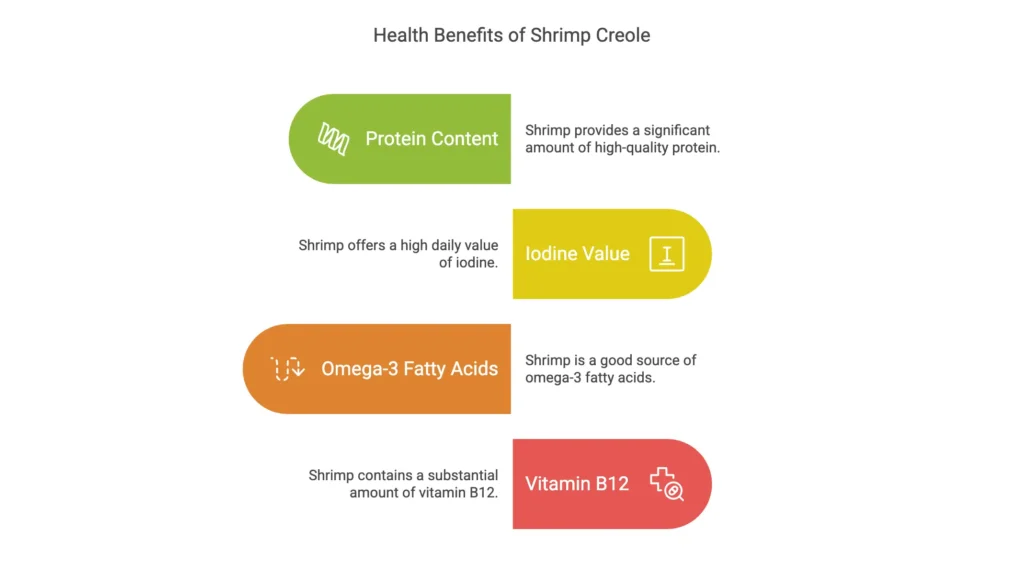Table of Contents
Being raised in Louisiana taught me that shrimp Creole goes beyond just a meal. It’s a story passed down through generations. My grandmother’s kitchen was always filled with the rich smells of her shrimp Creole. It showed the vibrant food culture of New Orleans.
This classic dish from Louisiana mixes juicy Gulf shrimp with a spicy tomato sauce. Each bite is a story of cultural mix, blending French, Spanish, African, and Native American flavors into one amazing meal.
Whether you’re an experienced cook or just starting out, I’ll guide you through making perfect shrimp Creole. Get ready to make your dinner table special with a dish full of history and flavor.
Key Takeaways
- Shrimp represents a vibrant fusion of multicultural culinary influences
- The dish combines fresh Gulf shrimp with a spicy, complex sauce
- Authentic recipes reflect generations of Louisiana cooking traditions
- Preparation techniques can be adapted for various skill levels
- The recipe offers a delicious glimpse into New Orleans’ culinary heritage
Understanding the Rich Heritage of Shrimp Creole
New Orleans shrimp creole is more than a meal. It’s a journey through Louisiana’s vibrant culture. This dish is a delicious mix of cultural influences that have shaped Southern food for years.
The story of shrimp creole starts with New Orleans’ diverse culture. It shows the city’s complex history. This dish is a blend of French, Spanish, African, and Native American cooking traditions.
Origins in New Orleans Cuisine
In 19th-century Louisiana, cooks made something amazing with local ingredients. Shrimp creole was born from their creativity and resourcefulness. It combines:
- Fresh Gulf Coast shrimp
- Local vegetables
- Rich, spicy sauce
- Innovative cooking techniques
Cultural Significance in Louisiana
Shrimp creole is more than food. It stands for community and strength. Families passed down recipes, adding their own twist while keeping traditions alive.
Evolution of Traditional Recipe
Chef John Besh has played a big role in keeping these recipes alive. His cookbook “My New Orleans” shows how to make shrimp creole the authentic way. It inspires both home cooks and professional chefs.
The recipe has grown from a simple home dish to a celebrated favorite in top restaurants. It shows the lasting charm of New Orleans cuisine.
Essential Ingredients for Authentic Shrimp Creole
Making a real Shrimp Creole begins with knowing what’s in the sauce. This Louisiana classic is all about the right ingredients. They add depth and complexity to every bite.

Shrimp Creole: Ultimate Taste Sensation
Equipment
- Large Skillet or Dutch Oven – For cooking the sauce and shrimp.
- Cutting Board & Sharp Knife – For chopping vegetables.
- Mixing Bowls – For seasoning shrimp.
- Measuring Cups & Spoons – For accurate ingredient portions.
- Wooden Spoon or Spatula – For stirring the sauce and shrimp.
- Serving Bowls or Plates – For plating the dish beautifully.
Ingredients
For the Shrimp Creole:
- 1 lb large shrimp peeled and deveined
- 2 tablespoons olive oil or butter
- 1 onion diced
- 1 green bell pepper diced
- 1 celery stalk diced
- 3 cloves garlic minced
- 1 can 14.5 oz diced tomatoes
- 1 cup tomato sauce
- ½ cup chicken or seafood broth
- 1 teaspoon Worcestershire sauce
- 1 teaspoon hot sauce optional, for extra heat
- 1 teaspoon paprika
- 1 teaspoon Creole or Cajun seasoning
- ½ teaspoon dried thyme
- ½ teaspoon black pepper
- ½ teaspoon salt
- ½ teaspoon red pepper flakes optional, for spice
- 1 bay leaf
- ½ teaspoon sugar to balance acidity, optional
- 2 tablespoons fresh parsley chopped
- 2 green onions chopped (for garnish)
For Serving:
- Steamed white rice or brown rice
- Lemon wedges optional
Instructions
Step 1: Sauté the Vegetables
- Heat olive oil or butter in a large skillet or Dutch oven over medium heat.
- Add onion, bell pepper, and celery (the “Holy Trinity” of Creole cuisine) and sauté for 5 minutes until softened.
- Stir in garlic and cook for 30 seconds until fragrant.
Step 2: Make the Sauce
- Pour in diced tomatoes, tomato sauce, chicken broth, Worcestershire sauce, and hot sauce.
- Add paprika, Creole seasoning, thyme, black pepper, salt, red pepper flakes, and bay leaf.
- Stir well and bring to a gentle simmer. Cook for 15-20 minutes, stirring occasionally.
Step 3: Add the Shrimp
- Add the shrimp to the sauce and stir to coat.
- Simmer for 5-7 minutes, or until the shrimp turn pink and are fully cooked.
- Remove the bay leaf and discard.
Step 4: Serve & Garnish
- Stir in fresh parsley and adjust seasoning if needed.
- Serve hot over steamed rice, garnished with green onions and lemon wedges.
Video
Notes
- Calories: ~375 kcal
- Protein: ~35g
- Carbohydrates: ~40g
- Fiber: ~6g
- Sugar: ~8g
- Fat: ~10g
- Saturated Fat: ~2g
- Sodium: ~750mg
- Potassium: ~600mg
So, what does Creole taste like? It’s a mix of bold flavors that excite your taste buds. Here are the key parts that make Shrimp Creole a true culinary gem:
- Fresh Gulf Shrimp: The main attraction, usually 2 pounds of big, raw shrimp
- The Holy Trinity of Vegetables:
- Onions
- Bell peppers
- Celery
- Aromatic Spices:
- Creole seasoning (2 teaspoons)
- Louisiana-style hot sauce
- Garlic
For the best Creole taste, use fresh, top-notch ingredients. Together, they make a sauce that’s both rich and complex.
| Ingredient Category | Key Components | Flavor Profile |
|---|---|---|
| Protein | Large Gulf Shrimp | Sweet, Delicate |
| Vegetables | Onions, Bell Peppers, Celery | Aromatic, Savory |
| Spices | Creole Seasoning, Garlic | Bold, Spicy |
| Additional Flavor | Louisiana Hot Sauce | Tangy, Spicy |
Every ingredient is vital for Shrimp Creole’s unique taste. Vegetables give a base flavor, and spices add heat and depth. This makes the dish unforgettable.
Mastering the Classic Creole Sauce Base
Creating an authentic easy shrimp creole with rice starts with understanding the soul of Creole cooking: its incredible sauce. The foundation of this magical culinary experience lies in carefully crafted techniques passed down through generations of Louisiana home cooks.
I’ll share the secrets to developing a rich, flavorful sauce that transforms simple ingredients into an extraordinary meal. Drawing inspiration from the barefoot contessa shrimp creole recipe, I’ve perfected a method that brings out the deepest flavors in every bite.
The Holy Trinity: Onions, Celery, and Bell Peppers
The heart of any great Creole sauce begins with the traditional holy trinity of vegetables:
- Diced onions (1 cup)
- Chopped celery (1/2 cup)
- Green bell peppers (1/2 cup)
Perfecting the Roux
A perfect roux is the secret weapon of Creole cooking. I recommend using 4 tablespoons of butter and carefully browning it to create a rich, nutty base. The key is patience – low and slow develops the most incredible depth of flavor.
Seasoning Secrets
My favorite seasoning combinations include:
- Louisiana-style hot sauce (1 tablespoon)
- Worcestershire sauce (1 tablespoon)
- Ground white pepper (1/4 teaspoon)
- Cayenne pepper (1/4 teaspoon)
- Dried thyme leaves (1/2 teaspoon)
Pro tip: Always taste and adjust seasonings gradually. The magic of a great Creole sauce is in its balanced, complex flavor profile that dances on your palate.
Selecting and Preparing Fresh Shrimp

Making a true recipe for shrimp creole new orleans style begins with the right shrimp. Gulf Coast wild-caught shrimp are the top choice for this Louisiana classic. When you shop, find shrimp that smell fresh and look firm and clear, without any color changes.
For the best shrimp creole, pick shrimp with these traits:
- Wild-caught Gulf shrimp (preferably 21-25 or 36-50 count per pound)
- Fresh or IQF (individually quick frozen) to keep quality
- Firm texture with no strong fishy smell
- Shells intact and without black spots
Preparing your shrimp needs careful steps. Deveining is key for a clean, tasty flavor. Start by removing the shell, keeping the tail for looks. Use a small knife to make a shallow cut along the shrimp’s back, then remove the dark digestive tract.
Experts say to use 2 to 2.5 pounds of raw shrimp for a traditional New Orleans Shrimp Creole. This amount serves 4 to 6 people, with each getting 4-6 ounces. Tip: If using frozen shrimp, thaw them in cold water for about 15 minutes before cooking.
Cooking thawed shrimp is fast – just 2 to 3 minutes to avoid overcooking. Remember, perfectly cooked shrimp are plump, slightly curved, and bright, pink-white in color.
Step-by-Step Shrimp Creole Recipe
Get ready to dive into an authentic pioneer woman shrimp creole recipe. It will take your taste buds straight to New Orleans! I’ll guide you through making a mouthwatering dish. It combines classic Louisiana flavors with simple cooking techniques.
My chicken and shrimp creole recipe is both delicious and easy to make. Before we start, let’s go over the key preparation details.
Preparation Time and Cooking Duration
- Prep Time: 15 minutes
- Total Cooking Time: 35 minutes
- Servings: 6
Temperature Control Tips
Cooking shrimp needs precise temperature control. Here are my top tips:
- Maintain medium heat when sautéing vegetables
- Cook shrimp quickly – about 2 minutes per side
- Avoid overcooking to prevent rubbery texture
Serving Suggestions
I recommend serving your shrimp creole over fluffy white rice. Garnish with fresh parsley and a sprinkle of cayenne for an extra kick.
| Ingredient | Quantity |
|---|---|
| Large Shrimp | 1.5 pounds |
| Olive Oil | 1 tablespoon |
| Butter | 3 tablespoons |
| Chicken Broth | 1.5 cups |
| Crushed Tomatoes | 15 ounces |
Pro tip: Store any leftovers in an airtight container in the refrigerator for up to 4 days.
Perfect Rice Pairings for Your Creole Dish

Looking for the perfect side dish for shrimp creole? Rice is the top choice, making your meal even better. It’s like a sponge for the rich, spicy sauce of the dish.
Here are the best rice options to make your shrimp creole unforgettable:
- Jasmine Rice: Its sticky yet fluffy texture is perfect for soaking up the creole sauce.
- Long-Grain White Rice: A classic pick that lets the dish’s flavors shine.
- Dirty Rice: A Louisiana favorite with meat and spices.
- Seasoned Rice: Cooked in flavorful stock for extra taste.
Need something low-carb? Try these alternatives:
- Cauliflower rice
- Spaghetti squash
- Quinoa
Pro tip: Use chicken or seafood stock instead of water for your rice. It adds more flavor. Adding fresh herbs can also boost the taste, making it a great match for your shrimp creole.
Storing and Reheating Your Shrimp Creole
After making a tasty shrimp creole with rice, it’s key to store it right. This keeps the flavor and texture just as good as when it was fresh. Here are my best tips for keeping your Creole dish ready for when you want it again.
Here’s how to store your shrimp creole with rice:
- Always use an airtight container
- Refrigerate within 2 hours of cooking
- Store in the refrigerator for up to 3 days
- Keep the rice and shrimp separate if possible
When reheating, be gentle to keep the dish in top shape. I suggest warming it up in a saucepan over low-medium heat.
| Storage Method | Duration | Recommended Temperature |
|---|---|---|
| Refrigerator | 2-3 days | 40°F or below |
| Freezer | Up to 3 months | 0°F |
Pro tip: When reheating, ensure the internal temperature reaches 165°F to guarantee food safety and maintain the best taste of your Shrimp Creole.
Freezing shrimp dishes can be a bit tricky. You can freeze Shrimp Creole, but the texture might change a bit. Thaw it overnight in the fridge for the best results.
Health Benefits and Nutritional Information
When you ask “is shrimp creole healthy?”, you’ll find it’s packed with good stuff. Shrimp is a nutrient powerhouse, making Shrimp Creole a great choice for a healthy meal.

A 4-ounce serving of shrimp brings big health benefits:
- 15.7 grams of high-quality protein
- 161% daily value of iodine
- 63% daily value of omega-3 fatty acids
- 53% daily value of vitamin B12
Shrimp Creole isn’t just about protein. The veggies like bell peppers, onions, and celery add important vitamins and minerals. They help boost your immune system and protect against damage.
| Nutrient | Amount per 100g | % Daily Value |
|---|---|---|
| Energy | 99 kcal | 5% |
| Protein | 24g | 48% |
| Fat | 0.3g | 1% |
| Calcium | 70mg | 7% |
Shrimp has cholesterol, but it might help your cholesterol levels. It can raise the good HDL cholesterol. The American Heart Association says shrimp is good for your heart if it’s not fried in too much oil.
So, is shrimp creole healthy? Absolutely! It’s full of lean protein, veggies, and can be eaten in the right amounts. It’s a smart choice for a healthy diet.
Variations and Modern Twists on Shrimp Creole
Culinary creativity has no limits with Shrimp Creole. This classic dish from Louisiana is perfect for personal touches. You can make it your own while keeping its rich cultural essence.
Spicing Up Your Flavor Profile
Everyone likes different levels of heat. Here’s how to adjust the spice in Shrimp Creole:
- Mild: Use less cayenne pepper and add sweet paprika
- Medium: Add a bit of jalapeño or green chili
- Fiery: Try habanero peppers or more Louisiana hot sauce
Creative Ingredient Alternatives
What makes Shrimp Creole different from Shrimp Gumbo? Creole uses tomato sauce, while gumbo has a darker roux. To make your Creole unique, try these swaps:
- Swap shrimp for crawfish or crab
- Add andouille sausage for more flavor
- Use coconut milk for a Caribbean flair
Dietary Modifications
Even with dietary needs, you can still enjoy Shrimp Creole. Here are some changes:
- Gluten-free: Use cornstarch for thickening
- Low-carb: Serve over cauliflower rice
- Vegetarian: Use firm tofu or jackfruit instead of shrimp
By trying these variations, you’ll keep Shrimp Creole’s spirit alive. And you’ll make it your own special dish.
Conclusion
As we finish our journey through Shrimp Creole, let’s remember it’s more than food. It’s a celebration of Gulf Coast food culture. The mix of flavors, rooted in Southern traditions, turns simple ingredients into a special meal.
Learning to make the perfect Shrimp Creole is more than following a recipe. It’s about understanding the techniques passed down through families like Gilliard Farms. From picking wild-caught shrimp to mastering the “holy trinity,” each step connects you to a rich culinary heritage.
Whether you’re making this dish for a family event or trying new cooking skills, remember it’s a canvas for creativity. It’s not only tasty but also packed with nutrients, making it a healthy choice for a flavorful meal.
I hope this guide has inspired you to dive into Creole cooking and create your own seafood feast. Get into the kitchen, let your passion shine, and enjoy the delicious journey!

